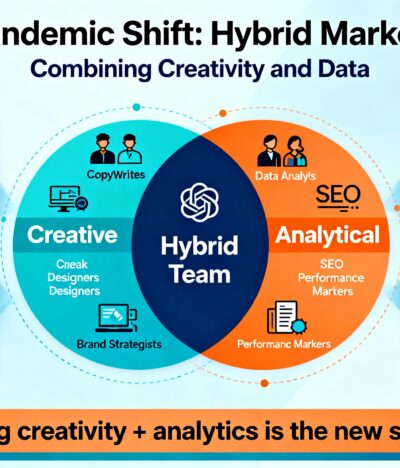In today’s digital-first economy, customers are bombarded with endless choices — ads, emails, offers, and content that demand attention every second. For marketers, the challenge is no longer just about reaching the customer, but predicting what they want, when they want it, and how to deliver it. Enter predictive marketing — a powerful blend of data, machine learning, and strategic insight that transforms marketing from reactive guesswork into proactive growth.
What is Predictive Marketing?
Predictive marketing uses historical data, artificial intelligence (AI), and machine learning (ML) to anticipate future consumer behaviors. Instead of relying solely on demographic information or past purchases, it analyzes patterns to forecast what your customers are likely to do next — whether it’s making a purchase, unsubscribing from an email list, or engaging with a campaign.
Think of it as giving your marketing strategy a crystal ball — but one based on data, not intuition.
From Reactive to Proactive
Traditionally, marketing efforts were reactive. Brands would launch a campaign, monitor its performance, and then adjust future campaigns based on what worked or didn’t. While this method has its place, it’s slow and often misses the opportunity to connect with customers in real time.
Predictive marketing flips the script. By anticipating user behavior, brands can engage customers before they even take action. Instead of waiting for someone to abandon their cart, predictive models can flag them as high-risk and trigger an offer or reminder automatically. Instead of sending blanket promotions, marketers can personalize offers to those most likely to convert.
How Predictive Marketing Works
At its core, predictive marketing involves three steps:
1. Data Collection
This includes everything from website behavior, email engagement, and purchase history to social media activity and customer support interactions. The more comprehensive the data, the more accurate the predictions.
2. Pattern Recognition via Machine Learning
Algorithms analyze past behaviors to identify patterns. For example, customers who buy Product A often buy Product B within two weeks. Or users who visit a pricing page twice in 24 hours are more likely to convert.
3. Actionable Insights and Automation
The final stage is using these predictions to trigger real-time actions — such as personalized recommendations, dynamic ad content, or lifecycle-based email campaigns.
Real-World Examples of Predictive Marketing in Action
Amazon’s Recommendation Engine
Amazon’s iconic “Customers who bought this also bought…” feature is powered by predictive analytics. Based on your browsing and purchase history, Amazon suggests products you’re likely to buy next — increasing average order value and enhancing the shopping experience.
Spotify’s Discover Weekly
Using listening habits, likes, skips, and playlist history, Spotify curates weekly playlists tailored to each user. The result? Higher user retention and engagement without relying on human curation.
Netflix’s Content Suggestions
Netflix leverages predictive models to recommend shows or movies based on viewing patterns. Their AI doesn’t just suggest what’s popular — it suggests what you are most likely to enjoy, increasing watch time and subscription retention.
E-commerce Cart Abandonment
Many e-commerce platforms use predictive models to identify when a user is likely to abandon their cart. Automated triggers then send personalized email reminders or offer limited-time discounts — often saving the sale.
Benefits of Predictive Marketing
-
Improved ROI: By targeting users more effectively, brands can reduce wasted ad spend and increase conversion rates.
-
Personalization at Scale: Predictive tools allow for deeply personalized experiences without manual effort.
-
Higher Customer Retention: Identifying churn risks early lets businesses act before it’s too late.
-
Smarter Content Delivery: Marketers can determine which type of content performs best for each user segment and deliver it at the right moment.
Challenges to Watch Out For
While the potential of predictive marketing is immense, it’s not without challenges:
-
Data Quality: Inaccurate or incomplete data can lead to flawed predictions.
-
Over-Reliance on Automation: Human creativity and oversight are still critical. Over-automating can lead to tone-deaf messages.
-
Privacy Concerns: With increased personalization comes the responsibility of handling data ethically and transparently.
Getting Started with Predictive Marketing
You don’t need to be a tech giant to implement predictive marketing. Here are a few starter tips:
-
Start Small: Begin with one use case — such as predicting churn or upsell opportunities.
-
Use Existing Tools: Platforms like HubSpot, Salesforce, and Google Ads already integrate basic predictive features.
-
Clean Your Data: The better your data hygiene, the more accurate your predictions.
-
Test and Optimize: Treat predictions like hypotheses. Test them and iterate based on results.
The Future of Marketing is Predictive
The age of spray-and-pray marketing is over. Consumers now expect brands to understand their needs, deliver relevance, and act instantly. Predictive marketing bridges the gap between expectation and execution.
In a world where attention is scarce and competition is fierce, the brands that thrive won’t be the ones that shout the loudest — they’ll be the ones that listen, learn, and anticipate. From guesswork to growth, predictive marketing isn’t just a trend — it’s the new standard.



